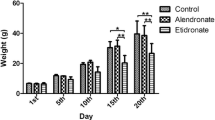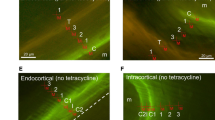Abstract
Two Diphosphonates, ethane-1-hydroxy-1,1-diphosphonate (EHDP) and dichloromethylene diphosphonate (Cl2MDP) inhibitin vitro bone resorption, which is either stimulated by parathyroid hormone or intrinsic in a bone remodeling culture system. While Cl2MDP is more effective than EHDP in inhibiting resorption, it also appears to result in a related diminution in osteoid formation. This effect causes a marked biochemical and morphological depression of bone remodelling with Cl2MDP at a concentration equivalent to 10-μg-phosphorus/ml of culture medium. The difference in activity between EHDP and Cl2MDP may be related to their relative affinities for the bone mineral surfaces and hence their effective free concentration in the bone extracellular fluid. It is hypothesized that diphosphonates may also affect bone formation indirectly if one assumes that the degree of mineralization of the matrix is important in the induction and regulation of osteoblastic activity in remodelling bone.
Résumé
Deux diphosphonates, à savoir l'éthane-1-hydroxy-1,1-diphosphonate (EHDP) et le dichlorométhane diphosphonate (Cl2MDP), inhibentin vitro la résorption osseuse qui est stimulée soit par la parathormone ou par voie intrinsèque dans un système de culture d'os en remaniement. Alors que le Cl2MDP est plus efficace que l'EHDP dans l'inhibition de la résorption, ce fait semble en rapport avec une diminution de le formation de tissu ostéoide. Il s'en suit une diminution biochimique et morphologique marquée du remaniement osseux avec le Cl2MDP à une concentration équivalent à 10 μg de phosphore/ml de milieu de culture. La différence d'activité entre l'EHDP et le Cl2MDP peu être liée à leur affinité relative pour les surfaces du minéral osseux et, par suite, à leur concentration effective dans la fluide extracellulaire osseux. Les diphosphonates pourraient aussi affecter l'os indirectement si l'on admet que le degré de minéralisation de la matrice est important pour l'induction et la régulation de l'activité ostéoblastique dans l'os en voie de remaniement.
Zusammenfassung
Zwei Diphosphonate, Aethan-1-hydroxy-1,1-diphosphonat (EHDP) und Dichloromethylen-Diphosphonat (Cl2MDP) hemmen in vitro die Knochenresorption. Diese wird verfolgt entweder mittels Stimulierung durch PH oder in einem Kultursystem, in welchem normale Knochenneubildung stattfindet. Während Cl2MDP die Resorption wirksamer hemmt als EHDP, scheint es ebenfalls eine Verminderung der Osteoidbildung zu verursachen. Dies bewirkt eine deutliche biochemische und morphologische Herabsetzung der Knochenneubildung, bei einer Cl2MDP-Konzentration von 10 μg Phosphor/ml Kulturmedium. Die unterschiedliche Wirksamkeit von EHDP und Cl2MDP läßt sich wahrscheinlich auf ihre verschiedenen Affinitäten zu der Oberfläche des Knochenminerals und somit auf ihre tatsächliche freie Konzentration in der extracellulären Flüssigkeit des Knochens zurückführen. Ausgehend von der Annahme, daß die Anregung und Regulierung der Osteoblasten-Aktivität bei der Knochenneubildung vom Ausmaß der Matrix-Mineralisation bestimmt wird, läßt sich die Vermutung aufstellen, daß die Diphosphonate die Knochenbildung auch indirekt beeinflussen können.
Similar content being viewed by others
References
Fleisch, H., Maerki, J., Russell, R. G. G.: Effect of pyrophosphate on dissolution of hydroxyapatite and its possible importance in calcium homeostasis. Proc. Soc. exp. Biol. (N.Y.)122, 317–320 (1966a)
Fleisch, H., Russell, R. G. G., Bisaz, S., Casey, P. A., Muhlbauer, R. C.: The influence of the effects of phosphonates on calcium metabolixm. In: Calcitonin '69 (Taylor, S., Foster, G. V., eds.) p. 409–417. London: William Heinemann Medical Books 1970
Fleisch, H., Russell, R. G. G., Straumann, F.: Effect of pyrophosphate on hydroxyapatite and its implications in calcium homeostasis. Nature (Lond.)212, 901–903 (1966b)
Golub, L., Glimcher, M. J., Goldhaber, P.: The effect of sodium fluoride on the rates of synthesis and degradation of bone collagen in tissue culture. Proc. Soc. exptl. Biol. (N.Y.)129, 973–977 (1968)
Michael, W. R., King, W. R., Francis, M. D.: Effectiveness of diphosphonates in preventing “osteoporosis” of dissuse in the rat. Clin. Orthop. Rel. Res.78, 271–276 (1971)
Minkin, C.: Inhibition of parathyroid hormone stimulated bone resorptionin vitro by the antibiotic mithramycin. Calcif. Tiss. Res.13, 249–257 (1973)
Muhlbauer, R. C., Russel, R. G. G., Williams, D. A., Fleisch, H.: The effects of diphophonates, polyphosphates, and calcitonin on “immobilization osteoporosis” in rats. Europ. J. clin. Invest.1, 336–344 (1971)
Reynolds, J. J.: Skeletal tissue in culture. In: The biochemistry and physiology of bone, vol. 1, 2nd ed. (Bourne, G. H., ed.). New York: Academic Press 1972
Reynolds, J. J., Minkin, C., Morgan, D. B., Spycher, D., Fleisch, H.: The effect of two diphosphonates on the resorption of mouse calvaiain vitro. Calcif. Tiss. Res.10, 302–313 (1972)
Russell, R. G. G., Muhlbauer, R. C., Bisaz, S., Williams, D. A., Fleisch, H.: The influence of pyrophosphate, condensed phosphates, phosphonates and other phosphate compounds on the dissolution of hydroxyapatitein vitro and on bone resorption induced in tissue culture and in thyroparathyroidectomized rats. Calcif. Tiss. Res.6, 183–196 (1970)
Smith, R., Russell, R. G. G., Bishop, M.: Diphosphonates and Paget's disease of bone. Lancet1971I, 945–947
Stern, B. D., Glimcher, M. J., Goldhaber, P.: The effect of various oxygen tensions on the synthesis and degradation of bone collagen in tissue culture. Proc. Soc. exptl. Biol. (N.Y.)121, 869–873 (1966)
Susi, F. R., Goldhaber, P., Jennings, J. M.: Histochemical and biochemical study of acid phosphatase in resorbing bone in culture. Amer. J. Physiol.211, 959–962 (1966)
Urist, M. R., Silverman, B. F., Buring, K., Dubuc, F. L., Rosenberg, J. M.: The bone induction principle. Clin. Orthop. Rel. Res.53, 243–283 (1967)
Author information
Authors and Affiliations
Rights and permissions
About this article
Cite this article
Minkin, C., Rabadjija, L. & Goldhaber, P. Boen remodelingin vitro: The effects of two diphosphonates on osteoid synthesis and bone resorption in mouse calvaria. Calc. Tis Res. 14, 161–168 (1974). https://doi.org/10.1007/BF02060292
Received:
Accepted:
Issue Date:
DOI: https://doi.org/10.1007/BF02060292




